|
|
||||
|
This one’s for Peanut. By Jo Nova We need to understand the MachineThe way Mike Benz explains the world, crazy things seem to make sense, but it is at its core, a dark and deep corruption that for most us, has been operating for our whole lives. It is, though, depressingly easy to believe that people with virtually unaccountable power, even those who start with good intentions, end up at the gates of hell, discussing “heart attack guns”. For the deep state, the dark art of influencing elections started on foreign governments, but once the CIA and State Department had honed the skills they needed, and broken every rule, what would stop them doing the same thing on domestic politics “to save democracy”? In a sense, it is as if a World War II no-holds-barred mentality has lived on to this day. If what Mike Benz says is correct, there is no way that those who apparently influence elections all over the world will give up that power easily, especially in the most important election. Mike Benz: Speedrunning The History Of The Intelligence StatePresented Hillsdale College, transcribed at RealClearPolitics Something has gone very wrong — that intelligence, which is supposed to serve the state, has subsumed it. The CIA was formed in 1947 and the first election they rigged was, allegedly in Italy in 1948. Just 12 days after that election a document was written called “The Inauguration of Organized Political Warfare” by George Kennan. It was kept secret and declassified nearly 60 years later in 2005. In it, Kennan admits the government has been conducting political warfare and says they cannot leave “unmobilized our resources for covert political warfare.” They had begun three months ago “specific projects in the field” and now needed to create a covert political warfare operations directorate. After World War II the CIA were afraid the communists were going to win in Italy. According to Benz, they spent the equivalent of $250 million US dollars (adjusted for inflation) to swing things in favor of their preferred candidate. They coopted, used, and exploited churches and charities. They beamed the US messages through Voice of America, and Radio Free Europe. They assessed that 60% of the voters would have chosen the communists if the CIA hadn’t intervened. …they set up a vast spawn of Italian news networks to create a surround sound inside that country to broadcast U.S. propaganda and messaging. We funneled aid money through churches and charity fronts to mafia and union street muscle. We worked with Hollywood to project Greta Garbo films and others into the country. The Voice of America and Radio free Europe were created specifically to be a tool of the CIA. Like a wartime propaganda unit but working in peacetime. The CIA battle in Italy was fundamentally dishonest. Benz claims they even went so far as to enlist the help of the mafia. They may have had noble aims, but they breached every principle the USA is supposed to stand on. It was called Political Warfare. As Benz describes it: Miles Copeland, one of the founding members of the CIA, wrote in his own book that, “Had it not been for the mafia, the Communists would by now be in control of Italy.” Once the CIA had tasted the fruit of election rigging, and gotten away with it, he claims they realized they needed a team in every country, just in case an inconvenient candidate looked like winning. Thus since World War II the US Empire has grown, not through conquering countries, but through “soft power”. The Italian election success lit a fire — but also crossed a line the US has not crossed since 1789. We might wonder if Benz is exaggerating and these operatives are just running amok in Venezuela, Bolivia and Russia? Would they really be so bold as to operate in democratic Western Nations? But then, if they did start in Italy… Today, he says, they use the exact same language and techniques to stop the rise of domestic populism on the Right.
The Spy agency became the Lie agency — they are paid to lie to youKennan, the creator of the original Political Warfare doctrine helped craft a memo NSC 10/2 that became a Presidential document that said sabotage, demolition, subversion, and propaganda was fine, as long as the government couldn’t be blamed for it. He later called it the greatest mistake he ever made: You’ll see this memo here, NSC 10-2, and it’s right here on the State Department website, under state.gov. What I’m about to read here sanctioned U.S. intelligence to carry out a broad range of covert operations, including propaganda, economic warfare, demolition, subversion, and sabotage. It was sponsored by George Kennan. He pushed for this right after he wrote “The Inauguration of Organized Political Warfare,” but he would later say it was the greatest mistake he ever made because of the monster it created. What NSC 10-2 did was give the intelligence community — this burgeoning, newly created CIA — and what we now have, 17 intelligence agencies plus the ODNI, not just spy organizations but lie organizations. What I mean by that is because of the phrase used in NSC 10-2, I’m going to read it: “All of these activities, which are normally illegal, can be carried out so long as they are planned and executed so that any U.S. government responsibility for them is not evident to unauthorized persons, and if uncovered, the U.S. government can plausibly deny any responsibility for them.” This is from 1948: “All covert operations, including sabotage, demolition, and controlling the media, are now legal as long as they are planned and executed so that any U.S. government responsibility is not evident to unauthorized persons.” So once the CIA was legally permitted to do “illegal” activities overseas, they had to lie about it to the outside world. And thus, as night follows day, then they also had to lie to the American people. After all, they could hardly tell the American people they were rigging elections in Italy without the rest of the world finding out. Thus do small lies beget bigger lies, and pretty soon everyone forgets they’re lying for Truth, Justice and the American Way. The people involved knew this breach was a monster, but thought they could contain it with the Smith-Mundt Act: Wisely the intel agencies were forbidden from using political warfare propaganda at home: In 1948, when the founding fathers of the intelligence state were setting this all up, they were intensely aware of the monster they were creating. In 1948, Congress passed the Smith-Mundt Act, because, again, in 1948, as all of this was being established, the CIA was brand new, and NSC 10-2 had just come out. Congress said, “Okay, okay, listen, you guys are creating a monster here. We want to make sure that we don’t build this empire of lies and that Americans are not being inundated with this sprawl of information control that you are conducting around the world in order to conduct organized political warfare on all countries on planet Earth.” That was until that safeguard was repealed by Barack Obama Even though the cheating and lies had been going on since WWII, if you have the feeling the world became extra crazy in the last ten years, perhaps there’s a reason: Many folks in this room are probably familiar with what happened during the Obama administration, which repealed this essential safeguard, which had been with us since the moment all of this was created in 1948, with very little fanfare. It was tucked into an NDAA. It was really only discovered by the public after the damage had been done that the Smith-Mundt Act was modernized to get rid of that restriction. It was effectively amended, and the headline was, “U.S. Repeals Propaganda Ban, Spreads Government-Made News to Americans.” For decades, this anti-propaganda law prevented the U.S. government’s mammoth broadcasting arms from delivering programming to American audiences. “Mammoth” is not a big enough word. The American hard power of World War II evolved into American domination by soft power in peacetime: After World War II, at this exact time in 1948, the UN Declaration for Human Rights came out and forbade the territorial acquisition of other countries by military force. Against these new international norms and standards, international law, you could not simply have a military occupation of the Philippines like the United States had in the early 1900s. So, with hard power ruled out as the dominant means to have an empire, the U.S. transitioned to a soft power empire, dominated by agencies like the Central Intelligence Agency, democracy promotion programs at the State Department, later USAID, and the whole swarm army we’re about to meet. After Italy, the CIA was legion, all over the world. The scope and size of this operation spread like cancer: What happened after 1948? There is a list of CIA regime change operations after Italy. The CIA orchestrated coups in 85 countries following the Italy operation that George Kennan and other State Department officials were so inspired by. They did achieve their goal of expanding this strategy to virtually every country, continent, and region on earth and building these networks, whether they were needed or not. Fifty of these regime change operations took place during the Eisenhower administration between 1952 and 1960. Fifty regime changes by 1960! No wonder Eisenhower warned us about the Military Industrial Complex. By the 1960s and 1970s the pushback to this was growing. A populist leftist faction arose to oppose the CIA. Left leaning protestors, naturally, were sympathetic to the socialist and communist countries the CIA was controlling. They saw the pain the intelligence agents were inflicting. Mike Benz refers to the article Seymour Hersh wrote in 1974 in the New York Times exposing the CIA. By the early 1960s, this began to come home, leading to a chain of events that caused the first real structural change to the intelligence state. During that time, the intelligence state was targeting the New Left within the Democratic Party in much the same way it is targeting the populist right today. There was a new faction within the Democratic Party, made up of not necessarily limousine liberals but anti-war protesters, civil rights activists, and supporters of third-world people’s movements. Many in the Democratic Party were socially, politically, and informationally aligned with countries targeted by the CIA. The CIA was seen as a right-wing force because it was primarily targeting socialist and communist governments, aiming to privatize state-held industries. The agency began to do the same things against the left that they are now doing against the populist right. Just to show how dark and malevolent this force had begun, imagine, a heart-attack gun:Think of a democratic agency working on ways to assassinate world leaders and make it look like a heart attack. That’s not what all the CIA and FBI shows look like on TV: [32 minutes]: This is Frank Church here on the left, holding up the famous “heart attack gun,” which was in the CIA assassination guide and part of their research and development. They were assassinating world leaders, political dissidents all over the world, and were working on ever more extreme ways to kill people and get away with it, adhering to their government license for plausible deniability. The heart attack gun, which you can look up on YouTube, was discussed in an open hearing of Congress, with the director of the Central Intelligence Agency testifying. It was essentially a dart gun that induced a heart attack, making the cause of death appear natural. On the right here is Christopher Pyle. He was one of the first whistleblowers to expose what was going on—not from the CIA, but from the U.S. Army. He provided very damning evidence that the U.S. military had active operations to survey and infiltrate any public meeting of 20 or more people in the United States, regardless of the group’s political affiliation—right, left, mothers’ knitting groups, religious groups, etc. He revealed troves of documents showing that the U.S. military perceived it was necessary to maintain political control over the civilian population to prevent any popular bills from getting passed or people from getting elected who might undermine the military agenda. This amounted to a basic usurpation of the concept of civilian-run government in a democracy. According to Benz, the CIA had worked its way into popular culture, the media, music, even churches: At that time, many thought leaders within the targeted section of the Democratic Party began to realize, due to these disclosures, that almost everything around them was not real—their media, culture, and music were all being used as instruments of statecraft, often directly against them. [Mike Benz lists the CIA’s use of journalists and clergy in intelligence operations.] Very famous figures were involved in this, including many from spaces you might not expect. For example, Gloria Steinem, the famous feminist, was funded by the Congress for Cultural Freedom. At the time, our State Department was using this as a means to win the Cold War by promoting feminism to oppose patriarchal structures in countries east of Germany. Jimmy Carter conducted the Halloween massacre, firing 30% of the CIAI had no idea Jimmy Carter did something so useful: Even in the 1960s, labyrinthine money laundering and hiding it from public accountability were already very robust. The Church Committee hearings popped off, and then Jimmy Carter won in 1976, coasting on popular resentment against the intelligence state. He was fiercely opposed by the intelligence state and conducted what became known as the “Halloween Massacre,” where he fired 30% of the CIA’s operations division in a single night, dramatically cutting the agency’s budget. There was this brief moment of accountability and a rollback of these plausibly deniable octopus-like operations against the American people. After this Halloween massacre, Ronald Reagan reinstated the powers of the CIA, but the agency went underground, so to speak, keeping its visibility low. Then Ronald Reagan came to power. In 1983, he embarked on structural changes to the way the intelligence state worked in order to restore the powers the CIA had lost during the Carter administration, including signing into law the bill that established the National Endowment for Democracy, which is now today’s premier CIA cutout. The CIA became less visible because of its previous scandals and diffused itself into a liaison role within a public-facing network of captured institutions. The intelligence state moved into the whole of society, embedding itself into cultural and media organizations, universities, NGOs, and other publicly visible sectors. Despite all this power, the CIA is not running the world though, apparently the State Department is:When you see the CIA or the intelligence state do something, understand that it’s to serve a State Department official, a Pentagon official, or the stakeholders around them. It’s not a rogue agency in the sense that it answers to the State Department and does the dirty work. But what’s gone rogue is something much deeper than just the intelligence state—it’s the entrenched forces in diplomacy and defense that the CIA is tasked with serving and doing the dirty work for. To listen to Mike Benz is to wonder if the whole world became a defacto part of The American Empire, sold as peace, truth and freedom, but based on quite a few lies and a fiat currency that is at this moment spiraling into uncontrollable debt. It was an arrangement that benefited many people in the US and abroad, but ultimately was not the American Experiment we hoped it was. It’s easy to believe this shapes the bizarre Uniparty effect where both sides of politics end up looking so similar. On the plus side, Mike Benz, and so many others still believe in the US Constitution. His sole goal is free speech online. Mike Benz is Director for the Foundation for Freedom Online. He worked in the cyber section of the State Department under Trump in formulating foreign policy related to IT. He has written some speeches for Donald Trump. His aim is to preserve free speech online. By Jo Nova Four weeks before the biggest election in history, the The Wayback Machine, was hacked in a major DDOS attack. The site was restored partially, but for the moment operates as “read only”. It is not possible to ask the archive to save a page. In a strange coincidence, Google caching stopped earlier this year and officially ended in September. So there is suddenly no recognised source of common shared truth about the history of the internet at the moment. Officially, supposedly, they will be back in action, sometime, one day, and theoretically they are copying the same pages they normally copy, they just can’t update yet, or archive new pages… Imagine how convenient that might be if someone were planning to lie, cheat, or change their story after the election? So please, everyone, “keep a copy”, and tell your friends to keep copies too. Capture the screenshots. Save the page. Download the youtubes and save them. You never know when an election promise, a counting tally, a prediction, or a gaffe might disappear down a memory hole. Is it just a coincidence or was this the deep state blob at work? As Jeffrey Tucker says, the timing is perfect, but we just do not know. Deleting history helps people who want to cheat:
Without the Wayback Machine Chris Gillham couldn’t have shown how the second round of adjustments in our national climate database wiped out even more historic hot days. (See the graph changes below).  Sweeping changes in record hot days? The Bureau of Meteorology adjusted raw data to make ACORN 1 and has adjusted that further to make ACORN 2! Without the Wayback Machine we might not have a copy of the Victorian Government paper pushing for offshore wind power which accidentally admitted that all the onshore wind and solar plants they needed would require up to 70% of all agricultural land in the state. Without the Wayback Machine we wouldn’t have a link to the original government report that listed the climate models biggest prediction and the results that showed it was a complete failure. The missing hot spot is probably the most important feedback within the climate models. All the models predicted the most rapid heating would happen 10km over the tropics, but 28 million weather balloons hunted for that signal and found it never happened. This shows water vapor doesn’t amplify the warming, and there was no catastrophe coming. After skeptics pointed out the failure, the large 6 Chapter Report from 2005 quietly disappeared. All my links to references broke, but there was a full copy on the WaybackMachine so I could update that post. Every time government agencies screw up they want to hide the evidence. That’s why we need the Wayback Machine, and it’s why they need to shut it down. h/t Bally, Skepticynic, and Simon Thompson.
By Jo Nova Brave scientists at the CSIRO and BoM have dug hard through the sacred Arc of the Climate Covenant, CMIP-6, to discover the horrible truth that we only have seven years (just seven!) until we pass through the sanctified Target-of-Paris on Halloween of 2031. Channel Nine shares this “harsh deadline for humanity” and tells us the chance to limit global warming to the Paris Agreement goal of 1.5 degrees “will expire” then, like 2 for 1 sale coupon. They don’t quite explain what happens on November 1st, 2031 — but most people will assume it’s just like what happened after Prince Charles and Al Gore and the UN said we only had ten years to go (which was nothing). But the horror show continues, not in our climate, but in our science: where the work of past scientists is deleted, and dubious datasets get adjusted with secret algorithms and thermometers near incinerators and over hot bitumen carparks that may be 1,000 kilometers away. The CSIRO-BOM Blob have massaged Australia’s temperature record so it can fit their favourite climate model. Dishonestly, both institutions hide the heat of the Federation Drought, where places all across Australia recorded temperatures over 50 degrees in 1896. BoM and CSIRO delete the cooling trend their own experts recorded from 1900 to 1950 in Australia. (Deacon et al).
The BOM and CSIRO pretend the temperatures are accurate in the graph above. They don’t tell Australians that they keep adjusting the data, even a hundred years after it happened. Some poor towns didn’t know they were two degrees colder in World War I until the BoM “discovered” that in 2014. The people of Marble Bar thought they had the hottest heatwave in world history in 1923 until the BOM traveled back in time to delete it, I mean “correct it”. Temperatures in 1910 have fallen 22 degrees Fahrenheit in the last 10 years. At the current rate of decline, the 1920 miners of Marble Bar will be in an ice age by the end of the century. The irony is that the BOM ignore the hot temperatures of the 1800’s because they were not in standardized modern Stevenson screens, yet the BOM is happy to take those lauded Stevenson screen measurements from 1920 and drop them in a high speed homogenization-blender to adjust them by as much as 2 degrees. So the BOM can “adjust” the data to get any trend they want. Then there’s the added heat of a million tons of concrete and brick keeping our cities warm. And on top of that scientific hamburger, thermometers boxes shrank from 230 litres to 60 litres, and glass instruments became electronic ones. They don’t mention that their super accurate new gizmos can pick up brief changes in temperature that the old glass ones can’t. And possibly they can pick up the airport radars too. Maximum record temperatures may be a one-second-record, literally there and gone in a moment, and if it was radar interference, not even there at all. When asked, the BOM say they have calibrated and tested the different thermometers side by side, to show they are comparable, but they won’t release the data. As if the thermometer readings at Canberra airport are a national security issue. They also don’t mention that scientists in Australia were reporting that Australia was cooling from the 1890s to 1952. (Deacon et al) The ghastly heat of 1896, the Federation Drought, and the 50C record temperatures all over Australia all go down the memory hole. Lest we forget, those historic heatwaves.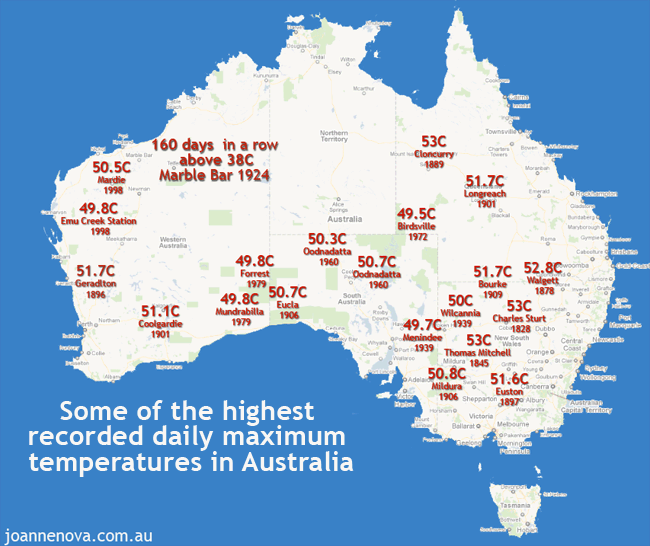 Historic heatwaves. 50 degree temperatures were everywhere, right across Australia in the 1800s and 1900s.| Not surprisingly, after we adjust all the records, we find extreme heat events are increasingAnd this is the shocking graph the BOM-CSIRO blob gave us in 2024: But ten years ago the BOM showed Australians a different graph, one which looked like this, til they took it off their own website. And there is bound to be some excuse to justify it. A different permutation or combination of variables, an older dataset, some plausible deniability. But the fact remains, that the BOM-CSIRO-blob are not trying to give Australians the whole truth and nothing but the truth: Reading the tea-leaves on rain in AustraliaBy selecting some contrived permutation the BOM-CSIRO-Blob can create the illusion that something unusual is happening. Here, they show the April to October rainfall in one particular part of the country as if this has some special meaning. (Their climate models fail on rainfall trends nearly universally). The Blob can cherry pick permutations until they find something. But here, even the best trend they can get doesn’t resemble our CO2 emissions. Why was the winter rain almost as low in 1940? The BOM don’t know. They could make up some reason post hoc, but they can’t predict it. If the BOM-CSIRO-blob wanted, they could show Sydney-siders the total rainfall record for the last 130 years. But they can’t because it would be obvious to everyone that it has nothing to do with CO2. It could just be noise in the system, oceanic oscillation, or cycles controlled by the sun. This (below) was the total rainfall in Sydney from 1840 to 2019, and the total number of rainy days, the peak amount of rain that falls in a single day and the intensity of the downpours. Why isn’t it in the State of the Climate? Why haven’t the BOM updated this graph? (From the Ashcroft paper of 2019).
 Rainfall trends, cycles, Australia, Sydney, Graph, 2019, 1840 – 2020..| Abbreviations: Rainday counts (RD), monthly rainfall totals (Rtot), and highest daily rainfall (Rx1day). The Simple Daily Intensity Index (SDII): the amount of rainfall received divided by the number of raindays recorded over a month and year. The exact same pattern is visible, by the way, in rainfall records from Melbourne and Adelaide too. But almost no one in Australia would know that. The ignorance isn’t an accident. Thank the BOM. Thank the CSIRO. Thank the ABC.
REFERENCESLindenAshcroftabDavid J.KarolyacAndrew J.Dowdyb(2019) Historical extreme rainfall events in southeastern Australia, Weather and Climate Extremes Available online 10 May 2019, 100210 Deacon, E.L. (1952) Climatic Change in Australia since 1880, Australian Journal of Physics, Volume 6, Pages 209-218. [PDF] State of The Climate 2024 can be found on the CSIRO and Bureau of Meteorology websites. State of the Climate 2022, Bureau of Meteorology State of the Climate 2022, CSIRO State of the Climate Report CSIRO 2014. CSIRO Previous State of the Climate Reports, CSIRO And even more droughts and trends graphs here.
By Jo Nova This week’s UN witchcraft is that a half a degree of global warming will kill babies and pregnant women, give us your money. The UN COP29 meeting starting Nov 11th, fights for relevance in the shadow of the US Election, like a suckerfish under an aircraft carrier. The latest confected attempt to get attention is to guilt trip the West — telling us that women and babies will die if we don’t install enough solar panels. This is despite humans being mammals which evolved to cope with the heat and the cold. We live a more closeted, protected existence than any time in the last million years. Not many people give birth in caves these days. Indeed we’re a species that inhabits towns with monthly temperatures that vary by 90 degrees Celsius and we are supposed to panic about another half a degree? The truth is that being cold, poor and hungry increases stillbirths just as much as any heatwave, and the thing that saves babies on a hot day is an air-conditioner. The answer to all four killers thus, is cheap electricity and fossil fuels. One day history students will study how the UN uses biblical paraphrasing to demand their tithe and control: Miscarriages due to climate crisis a ‘blind spot’ in action plans – reportThe report follows an ultimatum from the UN secretary general, António Guterres, on the climate emergency: “We’re playing with fire, but there can be no more playing for time. We’re out of time.” He said global heating was supercharging monster hurricanes, bringing biblical floods and turning forests into tinderboxes, and said governments had to rapidly wean the world off its fossil fuel addiction. Naturally, only babies that die from heat stress are politically marketable, the UN doesn’t care about the ones that die from the cold: Increasing climate extremes are causing more lost babies, premature births and cognitive damage to newborns, the report said. For example, a study in India found a doubled risk of miscarriage in pregnant women suffering heat stress, while another in California found a significant association between long-term heat exposure and stillbirth and premature birth. Awkwardly, cold temperatures also cause stillbirths and miscarriages (Ruan et al) so if man-made climate change is warming the world, it must be saving babies too. Shh! Five minutes of research, which the Guardian team don’t do, turns up a meta-study showing that poverty doubles the risk of death in babies: Numerous studies confirm that mothers of low socioeconomic status and unemployed parents face a far higher risk of having a stillbirth or a low birthweight child [7–10]. It has been demonstrated that women or families living in adverse socioeconomic conditions have twice the risk of having a stillborn baby compared to their more privileged counterparts [11]. Unemployment and unfavourable economic conditions are usually associated with poor maternal nutrition, elevated psychological stress during pregnancy and limited access to medical supervision and prenatal care. Several studies show that pregnant women with elevated levels of stress have considerably higher risks of a stillbirth, independent of age, parity, education, smoking and alcohol habits or other compromising characteristics…. Moreover, in low income countries or deprived environments, poor maternal nutrition and low body mass index can result in higher stillbirth frequency [15]. — Tsimbos et al (2021) Thus to save babies, and follow the science — we must burn more fossil fuelsWealthier nations have higher CO2 emissions, more heaters, more air conditioners, better food, and their babies don’t die as often. It is a crime the UN is not helping poor African nations build coal plants.  Child Mortality falls as CO2 emissions rise per capita. | OWID UPDATE#2: TonyfromOz asked where China was, and pointed out that it and many big countries were missing which is a great point. So here below are the top 25 largest in population plus a few other notables. As expected, the largest countries almost all fall in the centre of the trendline. 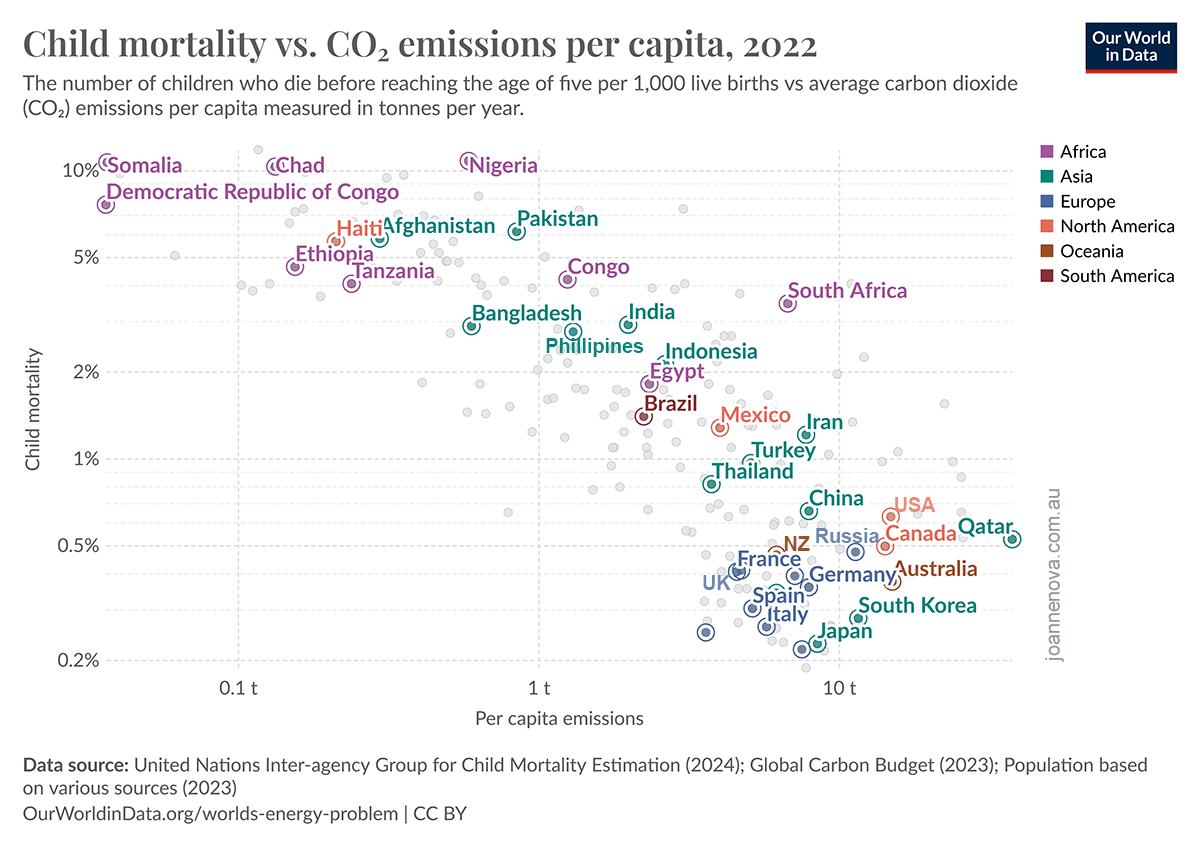 Child Mortality, CO2 emissions. OWID https://ourworldindata.org/grapher/child-mortality-vs-co2-emissions-per-capita
REFERENCES Cleon Tsimbos, Georgia Verropoulou Dimitra Petropoulou (2021) Economic crisis and stillbirth ratios: Evidence from Southern Europe, PLoS One, 2021 Nov 18;16(11):e0259623. doi: 10.1371/journal.pone.0259623 Ruan T, Yue Y, Lu W, Zhou R, Xiong T, Jiang Y, Ying J, Tang J, Shi J, Wang H, Xiao G, Li J, Qu Y, Mu D. Association between low ambient temperature during pregnancy and adverse birth outcomes: A systematic review and meta-analysis. Chin Med J 2023;136:2307–2315. doi: 10.1097/CM9.0000000000002361
 Photo by Ansalmo Juvaga Spare a thought for the people of CubaThe situation went from awful to something much worse. They ran out of working electrical plants ten days ago, and endured blackouts lasting for four straight days, including one hurricane. Reports coming out suggest that though electricity is partly restored, it’s often only for four hours a day. Not surprisingly, the country is semi-paralyzed — schools are still closed and “labor services” are largely non-existent, apart from hospitals, funerals and efforts to repair the damage caused by Hurricane Oscar. Soon they may run out of people. People were fleeing Cuba before things got this bad. The big blackout began on Friday October 18th. In the next four days they restarted the grid three or four times only to have it crash again, and while power is sort of mostly restored the structural problems appear to be dire. Nothing really sums the state of the communist economy better than one line on Vox news which described the moment the big blackout began: “Seven of the country’s eight thermoelectric plants, which generate power for the island, were not working or under maintenance prior to the Guiteras plant’s failure. So when the Guiteras plant shut down, there were no more energy sources.” As if “seven out of eight” is not bad enough, there’s more. Cuba can’t get subsidized fuel anymore from Russia, Mexico or Venezuela, and they can’t afford to buy fuel at market prices. The economy is kaput. They don’t make many things that the world wants to buy, and tourism dried up with the pandemic. It appears that either the only surviving plant suffered a malfunction, or the nation actually ran out of fuel, or both. Reuters is somewhat vague: Cuba power grid: How it collapsed and what comes nextReuters Long-time ally Venezuela slashed fuel shipments to Cuba by half this year as it struggles to assure supply at home. Allies Russia and Mexico have also cut exports to Cuba, forcing the cash-strapped government to seek far pricer fuel on the spot market. The situation came to a head on Friday, when Cuba’s largest power plant malfunctioned, joining several smaller plants already offline. Foul weather had also stalled the arrival of fuel from tanker ships offshore, starving the island’s power plants. The combination prompted the entire grid to collapse.
Since the order went out for all state workers to go home the day before the malfunction, the government evidently knew things were getting desperate.
Life is tough. Generators were only able to power hospitals for emergency situations. |
||||
|
Copyright © 2025 JoNova - All Rights Reserved |
||||

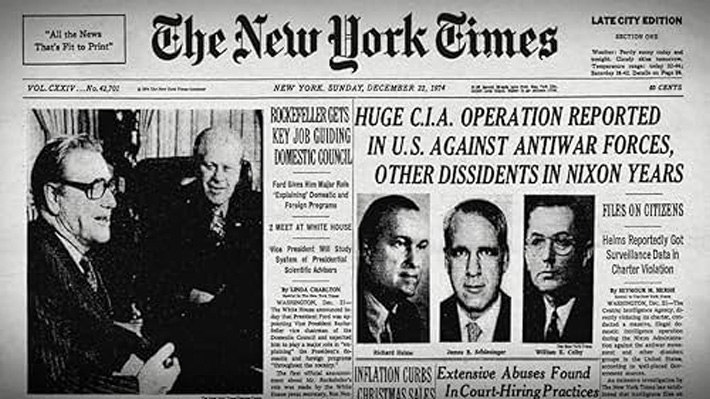




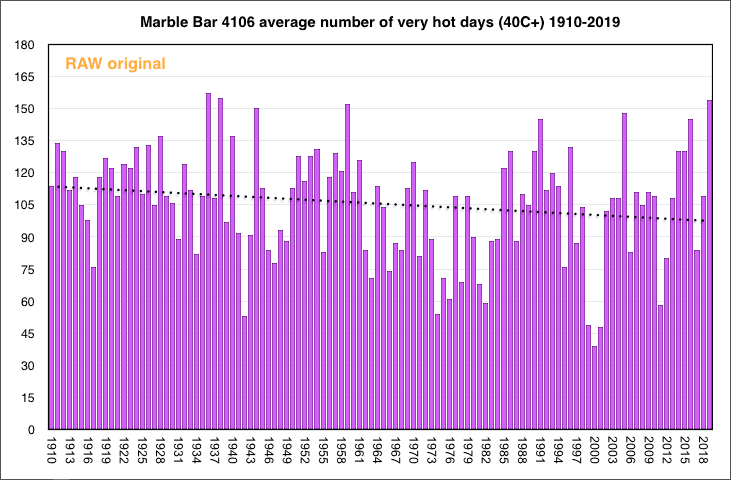

















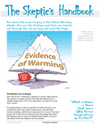
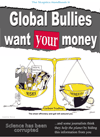





Recent Comments